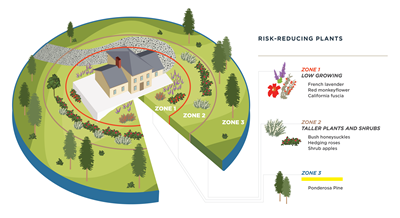The U.S. saw more than 10 million acres of land burn in wildfires in 2020 — an area twice the size of New Jersey — according to the Congressional Research Service. This was 20 percent more than the average burn over the last decade, and with hotter, drier weather and stronger winds predicted in the future, the trend is expected to continue. Now’s the time to talk to your residential customers about three tactics to reduce wildfire risk.
A good place to start with wildfire mitigation is creating defense zones around a home. FEMA (the U.S Federal Emergency Management Agency) recommends breaking out a 100-foot area around the house into three separate zones.
This is the area right outside the home and it’s important to keep this zone clean and clutter free. Think about clearing the roof, gutter and decking of combustible debris such as dry leaves or pine needles. Clear all combustible shrubs and bushes (like juniper), trees and dead plants away from home, it’s best to avoid having any plants here.
Now we move a little away from the house. Try to use non-flammable or low flammable landscaping materials like gravel, stone, and pavers in this area. If your customer wants a more natural look then ensure lawns are well irrigated and mowed. A few fire-safe plants and scrubs can remain in this zone (no more than 3 feet tall). One big thing to remember is that firewood should not be stored in Zone 1 or Zone 2 during wildfire seasons.
In this zone you can have denser tree and plant growth, but make sure that all trees are well maintained with branches trimmed away from the floor by 6 feet to 12 feet, and with thin canopies that do not touch the ground. The goals in Zone 3 are to improve the health of the wildlands and help slow an approaching wildfire.

Being fire safety conscious does not mean that your customers must strip their yards of life. In fact, the opposite is true – bare and dusty open spaces mean that wind can travel faster, pushing wildfire. According to FEMA, having the correct plant life can help mitigate the spread. There are loads of plants that are fire resistant — to a point. All plants will burn if the fire is hot enough, but there are some that are far less likely to ignite. Local species will vary from state to state so it’s worth doing your research.
The best thing that you can do for your customer is to regularly maintain their yard. Make sure dead leaves and branches are quickly picked up and disposed of outside the defense zones (some communities even have collection services for this garden waste.) Prune all tree branches to a minimum height of 6 feet off the ground and remove all branches that come within 15 feet of structures or other trees. Keep lawns and wild grass well mowed and irrigated.
You cannot guarantee customers a fireproof yard, but with your help customers can defend their homes and protect their communities.